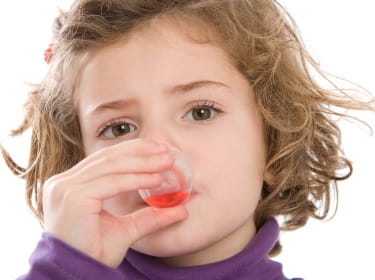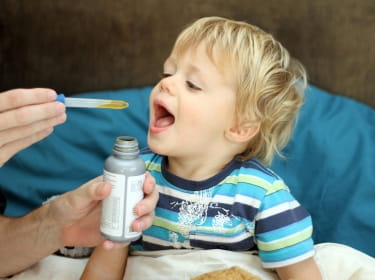Antibiotics: Overdose vs. Misuse

The Bottom Line
Antibiotic overdoses are rarely dangerous, but stomach upset and diarrhea may occur. Taking the wrong antibiotic is a problem if someone is allergic to the drug. Misuse of antibiotics is a problem for many reasons: an infection might not be cured, antibiotic-resistant organisms can develop, or, if a specific antibiotic is needed, it might not be effective.

The Full Story
Your child grabs her liquid antibiotic and takes a swig – or a nice long drink. Maybe she likes the sweet taste.
It happens all the time. Fortunately, it's rarely dangerous. Check the webPOISONCONTROL® online tool for guidance or call Poison Control at 1-800-222-1222. Whether you go online or call, you'll be able to determine whether you need treatment. Poison Control will ask you a few questions, and then tell you what to do.
Often, no treatment is needed for an antibiotic overdose. Usually, you'll need to watch for stomach upset and possibly diarrhea. In those cases, you should give extra fluids. Poison Control will stay in touch to be sure that there are no unexpected effects. You may need to contact the pediatrician's office to see if you need more antibiotic to complete the child's treatment, if that antibiotic was intended for a current illness.
What if a child swallows another child's antibiotic? Usually, that's not a problem either - unless there's a medication allergy. Call 911 right away if the child starts wheezing or having trouble breathing or breaks out in hives. Otherwise, call Poison Control right away.
If a one-time antibiotic overdose usually is not a problem, why is there so much publicity about antibiotics? The answer has to do with misuse of antibiotics.
Used correctly, antibiotics treat infections caused by bacteria; a common example in children is strep throat. When prescribed for bacterial infections, antibiotics are taken a certain number of hours apart for a specified number of days.
Antibiotics must be taken as long as prescribed, even though the patient usually feels better before the course is completed. The timing allows the concentration of antibiotic in the bloodstream to be maintained at an effective level. The length of treatment allows the antibiotic to kill off the bacteria causing illness. If antibiotics are stopped too soon, the infection may come back and require treatment again.
Antibiotics cannot treat infections caused by viruses or fungi. Most common respiratory infections, such as colds, flu, and sinus infections, are caused by viruses. Antibiotics should not be prescribed for viral infections because they are not effective. Giving antibiotics for viruses can't make the patient better - but might cause side effects and even allergic reactions.
Antibiotic resistance can result from taking antibiotics the wrong way or when they are not needed. Bacteria change or adapt over time; this is especially true of bacteria that are exposed to an antibiotic but not killed. When bacteria survive a course of antibiotics, another antibiotic must be used. If the bacteria become resistant to this one, yet another is required. The problem can continue until a particular bacterium cannot be treated at all, a phenomenon called multi-drug resistance.
Follow these tips to use antibiotics safely and correctly:
- Take antibiotics exactly as the label states: measure the correct dose, take (or give) each dose on time, and take the medicine for the full course that was prescribed.
- If mild diarrhea occurs, take plenty of fluids.
- All drugs have side effects, even common drugs like antibiotics. If other symptoms occur, check with the prescribing doctor.
- Do NOT take antibiotics without a prescription! Don't take someone else's medicine.
- Don't take left-over antibiotics from another illness.
If you have questions about your illness, or your child's illness, check with your health care provider. If you have questions about your prescription, contact your pharmacist. But if you think someone has taken too much antibiotic, use the webPOISONCONTROL® online tool for guidance, or call Poison Control right away at 1-800-222-1222.
Rose Ann Gould Soloway, RN, BSN, MSEd, DABAT emerita
Clinical Toxicologist
Poisoned?
Call 1-800-222-1222 or
Prevention Tips
Follow these tips to use antibiotics safely and correctly:
- Take antibiotics exactly as the label states: measure the correct dose, take (or give) each dose on time, and take the medicine for the full course that was prescribed.
- If mild diarrhea occurs, take plenty of fluids.
- All drugs have side effects, even common drugs like antibiotics. If other symptoms occur, check with the prescribing doctor.
- Do NOT take antibiotics without a prescription! Don't take someone else's medicine.
- Don't take left-over antibiotics from another illness.
This Really Happened
A 3-year-old child got into his antibiotic medication and drank almost 200 mL of the product (nearly 7 ounces). Because of the massive amount of medicine the child swallowed, he was taken to the emergency room. The child had blood in his urine; blood work showed that his kidney function remained normal. The child was treated with intravenous fluids at the hospital and sent home. He made a full recovery.
For More Information
Centers for Disease Control and Prevention National Center for Immunization and Respiratory Diseases, Division of Bacterial Diseases [Internet]. Atlanta. Get smart: Know when antibiotics work - Antibiotic resistance questions and answers. 2012 May 1 [cited 2012 Sep 13]; [about 6 screens].References
Poisoned?
Call 1-800-222-1222 or
Prevention Tips
Follow these tips to use antibiotics safely and correctly:
- Take antibiotics exactly as the label states: measure the correct dose, take (or give) each dose on time, and take the medicine for the full course that was prescribed.
- If mild diarrhea occurs, take plenty of fluids.
- All drugs have side effects, even common drugs like antibiotics. If other symptoms occur, check with the prescribing doctor.
- Do NOT take antibiotics without a prescription! Don't take someone else's medicine.
- Don't take left-over antibiotics from another illness.
This Really Happened
A 3-year-old child got into his antibiotic medication and drank almost 200 mL of the product (nearly 7 ounces). Because of the massive amount of medicine the child swallowed, he was taken to the emergency room. The child had blood in his urine; blood work showed that his kidney function remained normal. The child was treated with intravenous fluids at the hospital and sent home. He made a full recovery.
